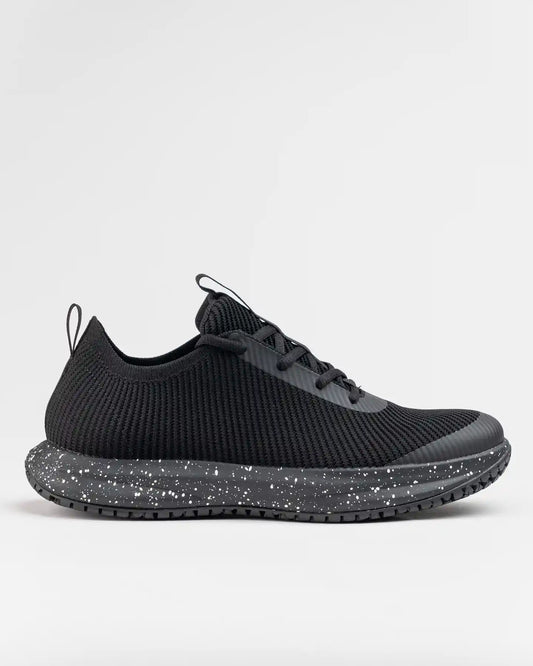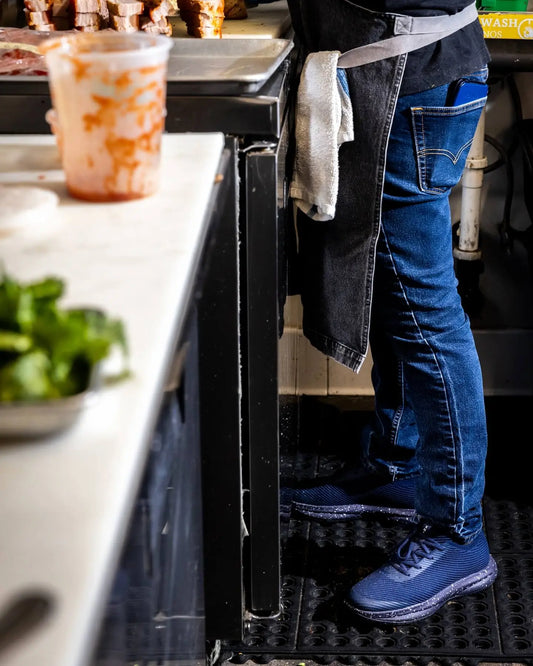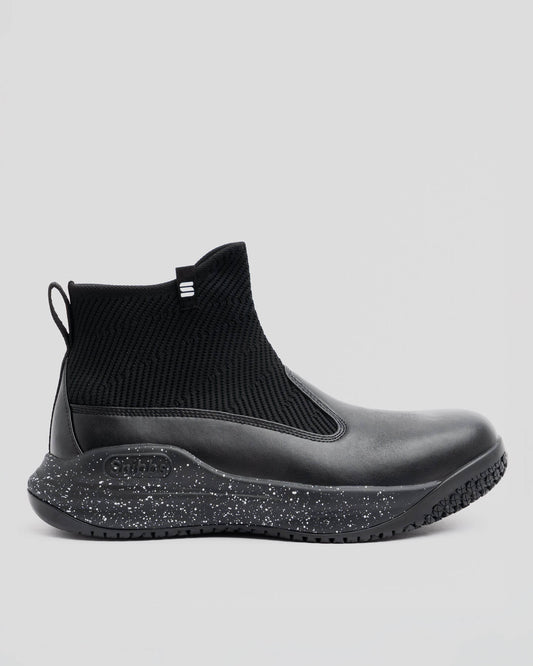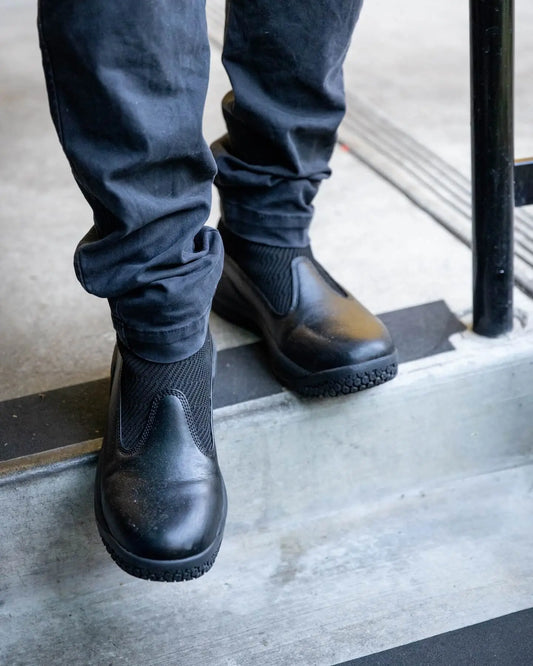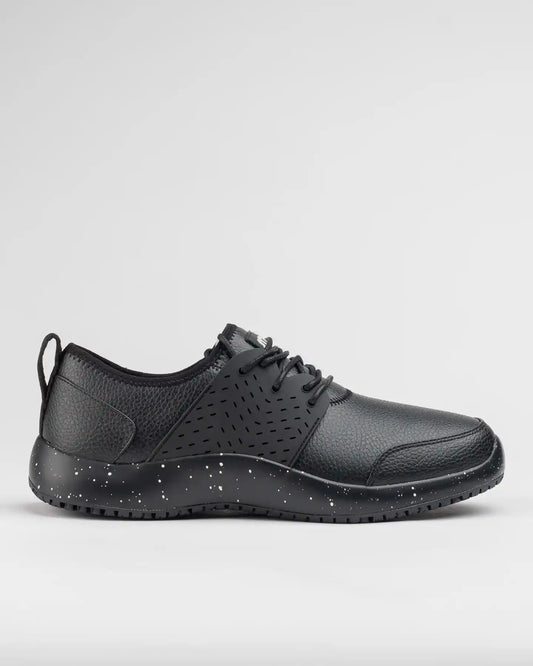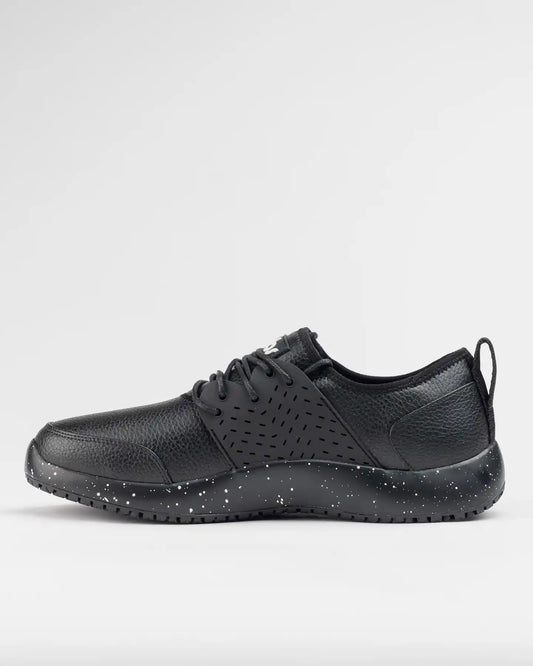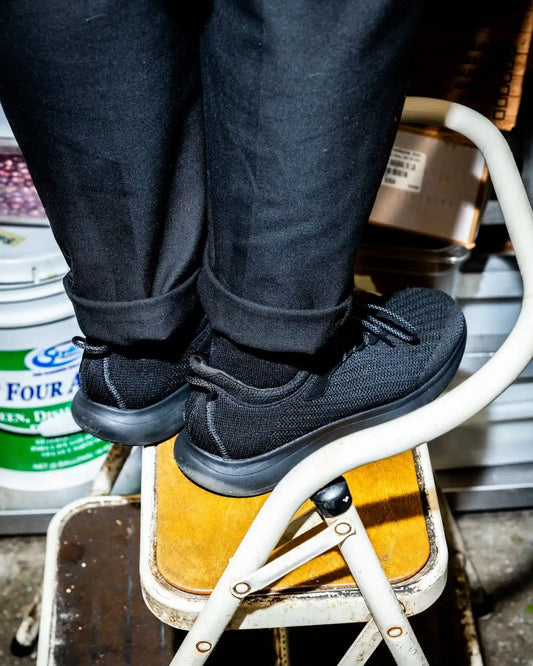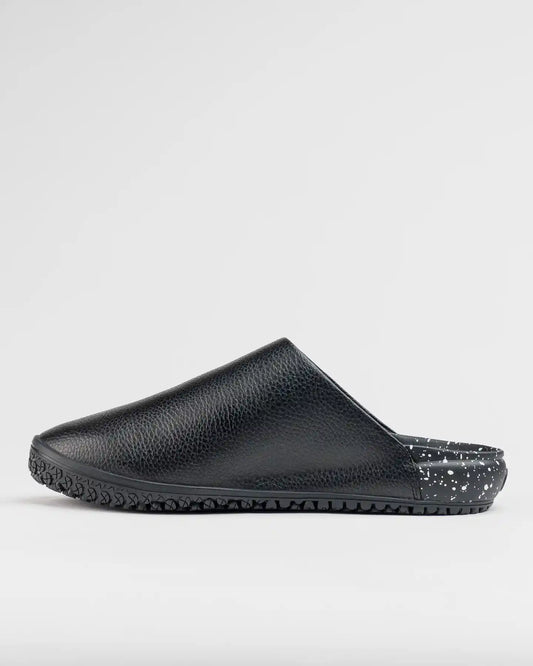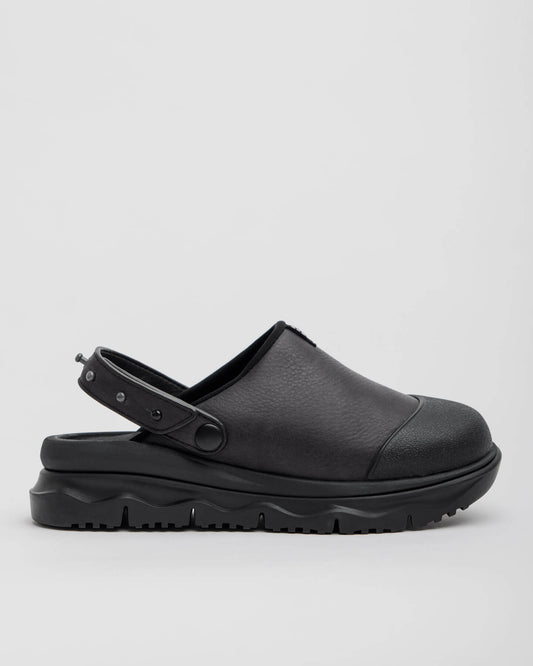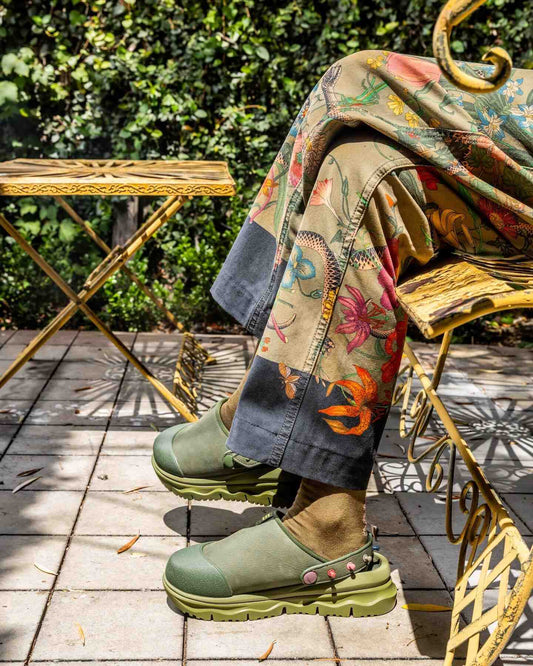How Slip Resistant Shoes Work
Alex Kinejara
The surfaces we walk on and the shoes we wear can both play a huge role in our safety and physical comfort. This is especially true for all of the driven professionals working in medical, food-service, events, and other industries that require workers to be on their feet throughout the day, navigating potentially slippery surfaces.
Luckily, there are innovative companies exclusively dedicated to creating safe, stylish, and comfortable shoe options—specifically, slip resistant shoes.
Whether you’re dodging a spill at work or hustling to catch the last bus, your best defense against slick surfaces is a first-rate pair of expertly engineered non slip shoes. Let’s explore how slip resistant shoes work, what to consider when evaluating different options, and why some slip-fighting shoes could have real benefits for your life.
How Slip Resistant Shoes Work
So, what are non slip shoes? Before we dive into the mechanics of this slip resistant footwear, it can be helpful to familiarize yourself with what these shoes are.
Slip resistant shoes are rubber-soled shoes with a deep tread that increases the shoe’s grip against the floor.
But how do slip resistant shoes work? By reducing slip risk with friction. Friction is essentially the act of one surface rubbing against another. The more friction between two surfaces—or between an object and a surface—the more difficult it is for those objects to slide against each other.1 When friction lacks, slip enters the scene.
Here’s how slip resistant shoes utilize friction to reduce slip:
- Texture of the material – Rubber’s roughness provides extra friction against smooth surfaces. To illustrate this point, we’re going to swap shoes for another accessory: hair bands. Picture a hair scrunchie made of the softest silk. It slips easily onto hair without catching or snagging. Now, picture the kind of rubber band you’d find in use at a hardware store. Due to its rough texture, that rubber band will pull and tug on every strand, increasing (you guessed it) friction.
-
Grooves in the sole – A sole shaped with grooves provides surface grip for every step by creating more friction between the slippery, smooth floor and your feet.
- Groove pattern – The groove pattern of the sole can also help reduce the risk of a fall. In fact, a tread pattern with parallel grooves is much less effective than a tread pattern where the grooves go in different directions. This friction helps your shoes grip the floor as you’re walking, running, or even sliding across the floor. A better grip helps reduce falls, slips, and trips among wearers.
So with the grooves in the shoe sole, the rubber outsole, and the tread pattern, the non slip shoe creates traction and prevents injuries on a slippery surface.
What’s the Difference Between Non-Slip and Slip Resistant Shoes?
When it comes to describing shoes, “non-slip” and “slip resistant” are terms that we typically use interchangeably. Both describe shoes with synthetic rubber soles specifically engineered to reduce the risk of slipping.
“Slip resistant” appears to be the term favored by scientific and consumer protection organizations that study how effectively certain styles of shoes can reduce workplace injuries. You’ll often see shoe companies use this term when they’re listing all of the essential qualities you need to know about a given shoe.
Here’s the key takeaway: Whether they’re called “non-slip” or “slip resistant,” they’ll help keep you and your coworkers safe.
Why Wear Slip Resistant Shoes?
Non-slip shoes, often in the form of server shoes or daily workwear, can help prevent workplace injuries, both minor and serious. According to the CDC, slips, trips, and falls are the third most common type of non-fatal work-related injuries throughout the United States.2 Reducing slips, trips, and falls not only improves quality of life for workers, it also helps employers by diminishing the need for workers’ compensation and worker turnover.
A CDC study provided proof that high-rated slip resistant shoes prevent food services worker injuries. Workers in the study who received free, highly rated slip resistant shoes had a 67% reduction in claims for slip injuries.2
Whether you’re a worker or an employer, slip resistant shoes are smart business.
Who Should Wear Slip Resistant Shoes?
While slip resistant shoes can benefit anyone, they’re especially necessary for people who work on their feet all day in occasionally slippery conditions. They’re commonly worn by those working in the following sectors:
- Food service
- Medical settings
- Industrial factories
- Any workplace that could have a wet or greasy floor
What To Look For in a Slip Resistant Shoe
When it comes to the slip resistant shoes currently available on the market, there’s plenty of variety to choose from. We recommend looking at the following criteria when deciding which slip resistant work shoes are best for you:
-
Effectiveness – First and foremost, slip resistant shoes are supposed to help keep you safe from injuries related to falling, slipping, or tripping. To evaluate a slip resistant shoe’s effectiveness, you can check the tread yourself. As we mentioned earlier, you’re looking for a rubber sole with several deep grooves, some of which go in different directions. We also recommend reading customer reviews of shoes you’re considering. You can also check to see if a slip resistant shoe is industry certified. For example, one respected certification is the Brugraber Mark II Test.
-
Longevity and value – Sticker price is an understandable priority for many consumers. Who wants to waste money? But if you want to maximize what’s in your wallet, it’s also important to consider the invisible costs of lower quality shoes. When your shoes wear out quickly, or their inferior quality gives you less protection in the event of a workplace accident, you could end up losing more money in the long run.
-
Style – It doesn’t matter how safe a shoe is if you avoid wearing it because you don’t like how it looks. Luckily, slip resistant shoes have come a long way since their invention. That’s why Snibbs has prioritized aesthetics as well as safety. We don’t think you should have to sacrifice style for function.
-
Water resistance – If you’re working in a place where the floor might be wet, you don’t want water (or any other mysterious liquids) soaking into your shoes. Make sure any shoes you’re considering are water resistant.
- Comfort – When you’re in the zone at work, the last things you want to focus on are aches and pains in your feet. A comfortable shoe frees you up to prioritize the things that matter most. Because you deserve more than shoe safety—you deserve comfort. At Snibbs, we engineer shoes for all-day orthopedic comfort.
Ultimately, only you can decide which shoe is the best fit for your needs and priorities. But researching these areas can help ensure you’re making an informed decision and choosing the best possible option for you.
Is It Worth It To Invest In Slip Resistant shoes?
The short answer: Yes. Your health, comfort, and safety are worth it.
But if you need a little more convincing, don’t worry. We’ve compiled below a few reasons why you want slip resistant shoes on your side (and in your shoe closet).
They Reduce Risk of Injury at Work
Slip resistant shoes are scientifically proven to reduce injuries in the workplace.3 In many cases, employers require you to wear slip resistant shoes because they know how true this is.
Here’s how you can benefit from non slip footwear across fields:
-
In food service, you’d be surprised how quickly a melted ice cube can turn an otherwise safe floor into a trepidatious workplace scenario.
-
In hospitals, everything from patient spills to freshly mopped floors can make a high-pressure job that much riskier than it needs to be.
- Those doing event work can also find themselves in need of that extra layer of anti-slip security as they weave through cocktail hours and buffet lines.
Slip resistant shoes can be even more vital for older workers. Studies suggest older workers are both more likely to fall, and more likely to sustain serious injuries when they do fall.
Additionally, studies of U.S. hospital workers and food workers have reinforced that slip resistant shoes can substantially reduce workplace injuries.4
Nonetheless, such footwear can be worn by everyone for injury, fall, or slip resistance.
They Support Day-to-Day Comfort and Long-Term Podiatric Health
While non slip footwear can provide safety, it can also provide comfort. Well-structured shoes can also reduce everyday physical pain that could otherwise be aggravated by being on your feet all day. Studies suggest that incorrectly fitting footwear is associated with foot pain and foot disorders, including:5
- Corns
- Calluses
-
Lesser toe deformity
Shoes built with superior cushioned insole support and a supportive foundation can increase comfort both while you’re working, and when you kick up your feet to relax at the end of the day. In the same vein, choosing a design with generous room in the toe box compensates for the foot swelling that can occur when people stand for extended lengths of time. All in all, these features allow for long-term comfort and healthy feet.
Investing in safe, stylish, and quality engineering that rises to the challenges of its environment is always a good idea. That’s true whether it’s your city, or your shoes.
Additionally, learning how to clean non slip shoes properly can make them last longer.
Step Into Comfort (and Safety) with Snibbs
Despite how crucial slip resistant shoes can be, there have been gaps in the slip resistant shoe landscape. We created Snibbs to fill that gap. The product of over three years of research, development, and testing, Snibbs offers universal work shoes engineered to support professionals across hundreds of industries.
With a variety of colors, such as white or black-slip resistant shoes for men, we have something to suit any style. To top it off, our slip resistant outsole is certified by the industry standard Brugraber Mark II Test, which indicates superior slip resistance and grip on wet floors coated with water, oil, grease, and other hazards.
If you want long-lasting protection, comfort, and style in your slip resistant shoes, consider Snibbs men's and women's black slip-resistant shoes.
Sources:
- Live Science. What is Friction? https://www.livescience.com/37161-what-is-friction.html
- CDC. slip resistant Shoes. https://www.cdc.gov/niosh/newsroom/feature/slipresistantshoes.html
- ScienceDirect. Reducing fall risk for home care workers with slip resistant winter footwear. https://www.sciencedirect.com/science/article/pii/S0003687020301824#
- Occupational and Environmental Medicine. slip resistant footwear reduces slips among National Health Service workers in England: a randomised controlled trial. https://www.ncbi.nlm.nih.gov/pmc/articles/PMC8223622/
- Journal of Foot and Ankle Research. Incorrectly fitted footwear, foot pain and foot disorders: a systematic search and narrative review of the literature. https://www.ncbi.nlm.nih.gov/pmc/articles/PMC6064070/
- Architectural Digest. Santiago Calatrava’s Ponte della Costituzione in Venice Is Getting a Makeover. https://www.architecturaldigest.com/story/venice-calatrava-bridge-glass-panels
- Money Wise. Understanding the 'Boots Theory' of Socioeconomic Unfairness. https://moneywise.com/managing-money/budgeting/boots-theory-of-socioeconomic-unfairness

